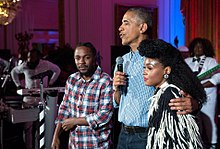Gangsta rap or gangster rap, initially called reality rap, is a subgenre of hip-hop that conveys the culture and values typical of urban gangs and street hustlers. Emerging in the late 1980s, gangsta rap's pioneers include Schoolly D of Philadelphia and Ice-T of Los Angeles, later expanding in California with artists such as N.W.A and Tupac Shakur. In 1992, via record producer and rapper Dr. Dre, rapper Snoop Dogg, and their G-funk sound, gangster rap broadened to mainstream popularity.
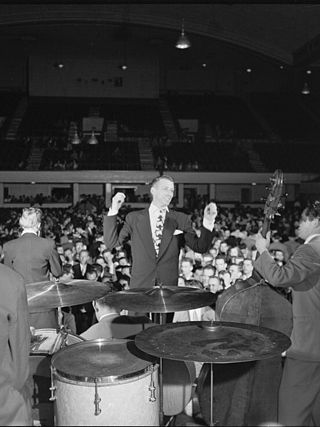
Progressive music is music that attempts to expand existing stylistic boundaries associated with specific genres of music. The word comes from the basic concept of "progress", which refers to advancements through accumulation, and is often deployed in the context of distinct genres, with progressive rock being the most notable example. Music that is deemed "progressive" usually synthesizes influences from various cultural domains, such as European art music, Celtic folk, West Indian, or African. It is rooted in the idea of a cultural alternative, and may also be associated with auteur-stars and concept albums, considered traditional structures of the music industry.
The new school of hip hop was a movement in hip hop music, beginning in 1983–84 with the early records of Run–D.M.C., Whodini, and LL Cool J. Predominantly from Queens and Brooklyn, it was characterized by drum machine-led minimalism, often tinged with elements of rock; rapped taunts, boasts, and socio-political commentary; and aggressive, self-assertive delivery. In song and image, its artists projected a tough, cool, street b-boy attitude. These elements contrasted sharply with funk and disco, novelty hits, live bands, synthesizers, and party rhymes of artists prevalent in the early 1980s. Compared to their older hip hop counterparts, new school artists crafted more cohesive LPs and shorter songs more amenable to airplay. By 1986, their releases began to establish hip hop in the mainstream.

Fugees are an American hip hop trio formed in 1990 in South Orange, New Jersey. Deriving its name from a shortening of the word "refugees", the group consists of Wyclef Jean, Pras Michel, and Lauryn Hill. The group rose to prominence in the mid-1990s for their pioneering blend of reggae, R&B, funk and hip hop, which eschewed gangsta rap and made them one of the most significant alternative hip hop acts. They occasionally rapped in Haitian Creole, and were one of the first hip hop bands to incorporate live instrumentation during their performances, along with the Roots.
East Coast hip hop is a regional subgenre of hip hop music that originated in New York City during the 1970s. Hip hop is recognized to have originated and evolved first in The Bronx, New York City.
West Coast hip hop is a regional genre of hip hop music that encompasses any artists or music that originated in the West Coast of the United States. West Coast hip hop began to dominate from a radio play and sales standpoint during the early to-mid 1990s with the birth of G-funk and the emergence of record labels such as Suge Knight and Dr. Dre's Death Row Records, Ice Cube's Lench Mob Records, the continued success of Eazy-E's Ruthless Records, Dr. Dre's Aftermath Entertainment, and others.
Southern hip hop, also known as Southern rap, South Coast hip hop, or dirty south, is a blanket term for a regional genre of American hip hop music that emerged in the Southern United States, especially in Atlanta, New Orleans, Houston, Memphis, and Miami—five cities which constitute the "Southern Network" in rap music.
Neo soul is a genre of popular music. As a term, it was coined by music industry entrepreneur Kedar Massenburg during the late 1990s to market and describe a style of music that emerged from soul and contemporary R&B. Heavily based in soul music, neo soul is distinguished by a less conventional sound than its contemporary R&B counterpart, with incorporated elements ranging from funk, jazz fusion, hip hop, and African music to pop, rock, and electronic music. It has been noted by music writers for its traditional R&B influences, conscious-driven lyrics, and strong female presence.
Underground hip-hop is an umbrella term for hip hop music that is outside the general commercial canon. It is typically associated with independent artists, signed to independent labels or no label at all. Underground hip hop is often characterized by socially conscious, positive, or anti-commercial lyrics. However, there is no unifying or universal theme – AllMusic suggests that it "has no sonic signifiers". "The Underground" also refers to the community of musicians, fans and others that support non-commercial, or independent music. Music scenes with strong ties to underground hip hop include alternative hip hop and conscious hip hop. Many artists who are considered "underground" today were not always so, and may have previously broken the Billboard charts.

Southernplayalisticadillacmuzik is the debut studio album by the American hip hop duo Outkast, released on April 26, 1994, by Arista Records and LaFace Records. Having befriended each other two years prior, rappers André 3000 and Big Boi pursued recording music as a duo and worked with production team Organized Noize, leading to a record contract with LaFace. With the team producing, Outkast recorded the album at the Dungeon, D.A.R.P. Studios, Purple Dragon, Bosstown, and Doppler Studios, all in Atlanta.

Although the music scene of Atlanta is rich and varied, the city's production of hip-hop music has been especially noteworthy, acclaimed, and commercially successful. In 2009, The New York Times called Atlanta "hip-hop's center of gravity", and the city is home to many famous hip hop, R&B, and neo soul musicians.
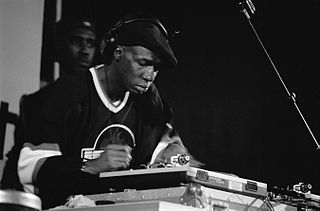
Hip hop or hip-hop is a culture and art movement that was created by African Americans, starting in the Bronx, New York City. Pioneered from Black American street culture, that had been around for years prior to its more mainstream discovery, it later reached other groups such as Latino Americans and Caribbean Americans. Hip-hop culture has historically been shaped and dominated by African American men, though female hip hop artists have contributed to the art form and culture as well. Hip hop culture is characterized by the key elements of rapping, DJing and turntablism, and breakdancing; other elements include graffiti, beatboxing, street entrepreneurship, hip hop language, and hip hop fashion. From hip hop culture emerged a new genre of popular music, hip hop music.

Golden age hip hop refers to mainstream hip hop music created from the mid or mid-late 1980s to the early or early-mid 1990s, particularly by artists and musicians originating from the New York metropolitan area. A successor to the new-school hip hop movement, it is characterized by its diversity, quality, innovation and influence on overall hip hop after the genre's emergence and establishment in the old-school era, and is associated with the development and eventual mainstream success of hip hop. There were various types of subject matter, while the music was experimental and the sampling from old records was eclectic.

Political hip hop is a subgenre of hip hop music that was developed in the 1980s as a way of turning hip hop into a form of political activism. Political hip hop generally uses the medium of hip hop music to comment on sociopolitical issues and send political messages to inspire action, create social change, or to convince the listener of a particular worldview. It was inspired partially by politically-focused 1970s artists such as The Last Poets and Gil Scott-Heron, as well as the Black Power movement and revolutionary politics of the 1960s and 1970s. Various hip hop artists emerged in the late 1980s espousing political messages and providing social and political commentary with KRS-One and his group Boogie Down Productions and Public Enemy in particular establishing themselves as some of the first predominantly political hip hop groups with albums in 1988. Soon to follow in 1989 and following years were other Political rappers, or known as "Conscious rap" including such groups as X-Clan, Poor Righteous Teachers, Paris (rapper), Disposable Heroes of Hiphoprisy and others The genre has helped to create a new form of social expression for subordinate groups to speak about their exclusions, injustices, and lack of power.
Hip-hop or hip hop music, also known as rap, and formerly as disco rap, is a genre of popular music that originated in the early 1970s by African Americans and Afro-Caribbean immigrants in the Bronx, a borough of New York City. Hip-hop music originated as an anti-drug and anti-violence genre consisting of stylized rhythmic music that often accompanies rapping, a rhythmic delivery of poetic speech. In the early 1990s, a professor of African American studies at Temple University said, "hip hop is something that blacks can unequivocally claim as their own." By the 21st century, the field of rappers had diversified by both race and gender. The music developed as part of the broader hip hop culture, a subculture defined by four key stylistic elements: MCing/rapping, DJing/scratching with turntables, breakdancing, and graffiti art. While often used to refer solely to rapping and rap music, "hip hop" more properly denotes the practice of the entire subculture. The term hip hop music is sometimes used synonymously with the term rap music, though rapping is not a required component of hip hop music; the genre may also incorporate other elements of the culture, including DJing, turntablism, scratching, beatboxing, and instrumental tracks.
Alternative hip hop is a subgenre of hip hop music that encompasses a wide range of styles that are not typically identified as mainstream. AllMusic defines it as comprising "hip hop groups that refuse to conform to any of the traditional stereotypes of rap, such as gangsta, bass, hardcore, and party rap. Instead, they blur genres drawing equally from funk and pop/rock, as well as jazz, soul, reggae, and even folk."
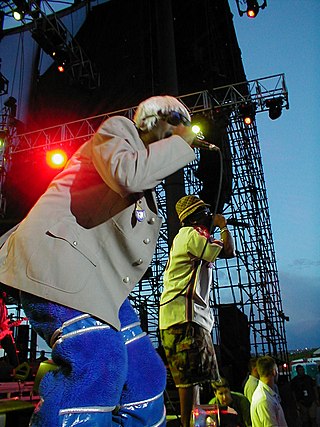
Outkast was an American hip hop duo formed in Atlanta, Georgia, in 1992, consisting of rappers Big Boi and André 3000. The duo achieved both critical and commercial success from the mid-1990s to the early 2000s, helping to popularize Southern hip hop with their intricate lyricism, memorable melodies, and positive themes, while experimenting with a diverse range of genres such as funk, psychedelia, jazz, and techno. The duo are widely regarded as one of the most influential artists in hip hop.
Comedy hip hop or comedy rap is a subgenre of hip hop music designed to be amusing or comedic, compared to artists who incorporate humor into their more serious, purist hip hop styles.
Hip hop music, developed in the South Bronx in the early 1970s, has long been tied to social injustice in the United States, particularly that of the African American experience. Hip hop artists have spoken out in their lyrics against perceived social injustices such as police brutality, poverty, mass incarceration, and the war on drugs. The relationship between hip hop music and social injustice can be seen most clearly in two subgenres of hip hop, gangsta rap and conscious rap.
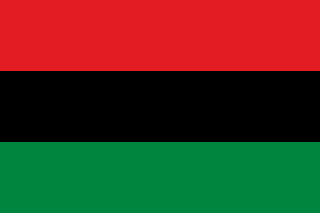
The Conscious Community, also known as the Black Conscious Community and the African Conscious Community, is a loose affiliation of allied groups composed of individuals from the African diaspora and from Africa. Pan-Africanism, Afrocentrism, Afrofuturism, Black Nationalism, and Black Liberation Religion/Spirituality are foundational sources for the ideologies found among individuals in the Black Conscious Community.
